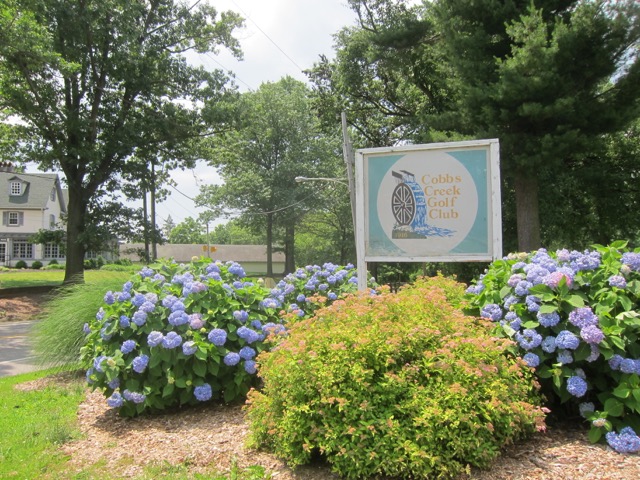On the day the only more racially imbalanced awards on the planet were announced, golf's annual effort to obtain good dinner speakers and maybe recognize some contributions means we know who will win the Donald Ross, Bobby Jones and PGA Lifetime Achievement Media awards.
From the ASGCA on Michael Bamberger receiving the Donald Ross Award:
Michael Bamberger – a senior writer for Sports Illustrated and author of several books on golf – has been chosen by the American Society of Golf Course Architects (ASGCA) as the 2016 recipient of the Donald Ross Award. The award, given annually since 1976, is presented to a person who has made a significant contribution to the game of golf and the profession of golf course architecture. It will be presented to Bamberger at the 2016 ASGCA Annual Meeting on April 24 in Bethesda, Maryland.
“Almost every golf fan over the past 30 years has read and been impacted by Michael’s writing, in newspapers, on the pages of Sports Illustrated, on the web or in his books,” said President Steve Smyers, ASGCA. “He brings his readers to the places they want to go – from major championships to traveling along on the European Tour – and shows them unique views of the golf world they might not otherwise experience. Michael’s keen observations about the game provide the casual golfer a greater understanding of the art of the game.
“We’re thrilled a writer of Michael’s caliber is devoting his talent to keeping the game front and center among sports fans,” he continued. “ASGCA respects his knowledge and perspective, and appreciates how his efforts benefit the game of golf.”
Bamberger grew up in Patchogue, New York, and was introduced to golf in an eighth-grade gym class. He first played on the public courses of Suffolk County and on the Patchogue-Medford High School golf team. After graduating from the University of Pennsylvania he became a newspaper reporter, working for the Vineyard Gazette, on Martha’s Vineyard, and later for the Philadelphia Inquirer. Since 1995, Bamberger has been a senior writer at Sports Illustrated. He also contributes regularly to golf.com and writes a back-page column for Golf magazine.
His books on golf include “The Green Road Home” (1986), about his experiences as a caddie on the PGA Tour in 1985; “To the Linksland” (1992), about an extended honeymoon trip Bamberger and his wife, Christine, made on the European golf tour and through coastal Scotland; and “Men in Green” (2015), a then-and-now look at various golf legends from the 1970s. He is the inventor of The E-Club, a utility golf club for which he was issued a U.S. patent.
Bamberger joins an impressive list of journalists who have received the Donald Ross Award, including Herbert Warren Wind, Peter Dobereiner, Charles Price, Dick Taylor, Ron Whitten, George Peper, James Dodson and Bradley S. Klein.
The USGA on Judy Bell, their 2016 Bob Jones award winner:
USGA to Honor Judy Bell with 2016 Bob Jones Award
FAR HILLS, N.J. (Jan. 14, 2016) – The United States Golf Association (USGA) will bestow its highest honor, the Bob Jones Award, to Judy Bell, of Colorado Springs, Colo., at an award ceremony on June 14, 2016, during the week of the 116th U.S. Open Championship at Oakmont (Pa.) Country Club.
Presented annually since 1955, the Bob Jones Award recognizes an individual who demonstrates the spirit, personal character and respect for the game exhibited by Jones, winner of nine USGA championships.
Known for her generous spirit and larger-than-life personality, Bell, a native of Wichita, Kan., has championed a welcoming and accessible game as one of its most prominent ambassadors for more than six decades.
“Judy is a towering presence in golf and her contributions to shaping the USGA can be seen to this day,” said Tom O’Toole Jr., president of the USGA. “Her devotion to the game makes her a worthy recipient of our organization’s most prestigious honor. From her earliest days as an accomplished player through her tenure as USGA president, Judy has been a staunch advocate and diplomat for the game. Those mantles were always delivered with her unique kindness and infectious personality. Judy is a real treasure!”
The youngest of four children and the only girl, Bell largely credits her mother’s tenacious, straightforward and generous personality, as well as her can-do attitude as her strongest influences. The USGA’s first female president (1996-1997), Bell possesses a passion for women’s and girl’s golf that continues today, particularly through the LPGA-USGA Girls Golf program, which she helped found.
Her two-year USGA presidential tenure was hallmarked by the establishment of the “For the Good of the Game” grants program, which dedicated more than $65 million toward national and local projects devoted to improving the lives of communities through accessible golf. Bell was the program’s director from 1999-2010, and asserted hands-on service focused on providing opportunity to and building character among countless youth, particularly minorities, girls and those with disabilities.
“I grew up around people who volunteered and it was something I felt strongly about, even as a child,” said Bell in her 2002 book, Breaking the Mold. “We all believed that if you’re asked and you have an opportunity to give back, you just step up to the plate and do what you can.”
Bell was also instrumental in the development and management of the USGA Foundation’s leadership and service fellowship program, which provided two-year, graduate-level training to nearly 70 young professionals interested in careers in the non-profit sector. Many fellows continue to serve in leadership roles for a variety of service-based organizations and associations. The program fostered strong relationships within the golf community to promote accessibility, particularly through state and regional golf associations.
“Judy has an amazing capacity to connect with people of all walks of life,” said Steve Czarnecki, a fellow of the USGA Foundation and its assistant director of grants and fellowship for 13 years. “To her, the USGA committee member, golf course superintendent at a host club, USGA staff member or state and regional golf association representative is every bit as important as anyone else in the sport – herself included. Judy wanted everyone to have an opportunity to experience the game and benefit from the many wonderful lessons it conveys.”
On the course, Bell was a passionate and well-respected amateur player who competed in 38 USGA championships, including three trips to the U.S. Women’s Amateur quarterfinals and one U.S. Girls’ Junior semifinals appearance. She also won three consecutive Kansas State Women’s Amateur titles from 1952-1954, the first at age 15. Bell also competed for the victorious 1960 and 1962 USA Curtis Cup Teams and captained the 1986 and 1988 USA Teams. The Women’s State Team Championship Trophy was named after her in 1998.
“Judy was the most fun captain I had in my playing career,” said Carol Semple Thompson, a seven-time USGA champion and 12-time USA Curtis Cup Team member. “She makes everyone feel welcome and happy. She is also a pioneer, becoming one of the most important women in golf administration. Her advancement to the Executive Committee and presidency was a natural progression of her hard work, her passion for the amateur game, and her relationships with so many players and people in golf.”
Bell’s volunteer career with the USGA began as a member of the U.S. Girls’ Junior Championship Committee (1961-1964). She served 17 years on the USGA Women’s Committee beginning in 1968, including four years as chairman (1981-1984). In 1987, Bell became the first woman named to the USGA’s Executive Committee and served on nearly every committee before becoming the Association’s 54th president in 1996.
“Tom O'Toole called me the other night and we chatted a while,” said Bell. “Then he told me that I was going to get the Bob Jones Award. I was floored and in denial. Tom is a great friend and finally convinced me it was real. I'm honored beyond words.”
A phone call from Tom O'Toole? And you say these award winners don't earn their keep!
And the PGA of America's Lifetime Achievement Award in Journalism...
George Peper of Vero Beach, Florida, the former Editor-in-Chief of GOLF Magazine for a quarter century and the author, co-author or editor of 20-plus golf books, has been named the recipient of the 2016 PGA Lifetime Achievement Award in Journalism.
Peper, 65, will be honored on April 6, during the ISPS HANDA 44th Golf Writers Association of America (GWAA) Annual Awards Dinner at Savannah Rapids Pavilion in Augusta, Georgia.
Peper is the 27th recipient of the PGA Lifetime Achievement Award in Journalism, which honors members of the media for their steadfast promotion of golf, both locally and nationally.
“George is simply a living legend in golf journalism—there is no other way to put it,” said PGA President Derek Sprague. “His leadership and quality of work at GOLF Magazine for more than 25 years, and now at LINKS Magazine, is unsurpassed. This dedication to his craft, along with his love of golf, resulted in his traveling the world as a golf ambassador and authoring numerous books on the subject. George is a true friend of the game who has enlightened us with his passion, candor and wit. We are fortunate he chose our sport to immortalize.”
A graduate of Princeton University, Peper was working toward a doctorate in comparative literature at Yale University when in 1976 he joined GOLF Magazine, becoming its chief editor a year later at the age of 27. For the last 13 years, he has written for LINKS Magazine, and in 2011, he became the magazine’s editor.
“What a thrill to be recognized in this way by the PGA of America,” said Peper. “I’m not sure I deserve an award after 40 years of having fun, but to join the distinguished company of the previous recipients—every one of whom I’ve been privileged to know—is both a humbling experience and a tremendous honor."
While at GOLF, Peper originated the magazine’s “Top 100 Courses in the World,” “America’s Top 100 Teachers” and the “World Golf Teachers Hall of Fame.” In 1988, he had a heavy hand in bringing together the game’s allied associations for the once-in-a-lifetime Centennial of Golf in America celebration.
Peper’s published works include, among others, “Golf Courses of the PGA Tour” (1984) and “Two Years in St. Andrews” (2006). He has co-authored books with Greg Norman and Bill Murray and edited several memorable works, including “Golf in America: The First 100 Years” (1988) and “The World’s 500 Best Golf Holes” (2000). In 1999 his script for the PBS documentary “The Story of Golf” was nominated for a sports Emmy.
A former board member for the National Golf Foundation and the Golf Writers Association of America, Peper also served on the USGA’s Bob Jones Award Committee.
In 2008, Peper was presented the Donald Ross Award from the American Society of Golf Course Architects for his contributions to golf and golf course architecture. A year later, he received the Lincoln Werden Award from the Metropolitan Golf Writers Association for his contributions to golf journalism.
Peper and his wife of 37 years, Libby, have two grown sons, Tim and Scott.




















